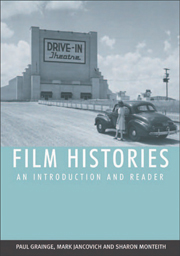Book contents
- Frontmatter
- Contents
- Preface
- Part I Film History from its Origins to 1945
- 1 The Emergence of Cinema
- 2 Organising Early Film Audiences
- 3 Nationalism, Trade and Market Domination
- 4 Establishing Classical Norms
- 5 The Age of the Dream Palace and the Rise of the Star System
- 6 Competing with Hollywood: National Film Industries outside Hollywood
- 7 The Rise of the Studios and the Coming of Sound
- 8 Realism, Nationalism and ‘Film Culture’
- 9 Adjustment, Depression and Regulation
- 10 Totalitarianism, Dictatorship and Propaganda
- 11 The Common People, Historical Drama and Preparations for War
- 12 Wartime, Unity and Alienation
- Part II Film History from 1946 to the Present
- Bibliography
- Copyright Acknowledgements
- Index
6 - Competing with Hollywood: National Film Industries outside Hollywood
from Part I - Film History from its Origins to 1945
Published online by Cambridge University Press: 05 August 2013
- Frontmatter
- Contents
- Preface
- Part I Film History from its Origins to 1945
- 1 The Emergence of Cinema
- 2 Organising Early Film Audiences
- 3 Nationalism, Trade and Market Domination
- 4 Establishing Classical Norms
- 5 The Age of the Dream Palace and the Rise of the Star System
- 6 Competing with Hollywood: National Film Industries outside Hollywood
- 7 The Rise of the Studios and the Coming of Sound
- 8 Realism, Nationalism and ‘Film Culture’
- 9 Adjustment, Depression and Regulation
- 10 Totalitarianism, Dictatorship and Propaganda
- 11 The Common People, Historical Drama and Preparations for War
- 12 Wartime, Unity and Alienation
- Part II Film History from 1946 to the Present
- Bibliography
- Copyright Acknowledgements
- Index
Summary
A glance around the world in the 1920s reveals a heterogeneous film history but one replete with anxieties about American cultural imperialism and the homogenising tendencies of mass culture. The German film industry competed most successfully with America in that its domestic productions outweighed foreign imports in the 1920s and Britain put up a very good fight at the box office, with 1927 its annus mirabilis. However, protectionist measures would characterise a decade in which national cinemas sought to hold their own against Hollywood's incursions into other national cinemas. Audiences in Australia, Canada and India, for example, received a diet of mainly American fare. The American challenge to European and other cinemas was also underwritten by the federal support that the American film industry received from the US Government's Commerce Department, designed to support a developing industry. Nevertheless, the national cinema that produced the highest number of films in the 1920s was Japan's. Japanese cinema was a domestic product, and rarely exported, yet its major studios were highly organised and vertically integrated and directors tended to enjoy more artistic freedom within the evolving studio system. The significance of Japanese cinema may have been ‘discovered’ in the West by Noël Burch in the 1970s but we see the beginnings of Yasuijuro Ozu's career as an auteur in the Japanese cinema of the 1920s.
- Type
- Chapter
- Information
- Film HistoriesAn Introduction and Reader, pp. 120 - 146Publisher: Edinburgh University PressPrint publication year: 2007



